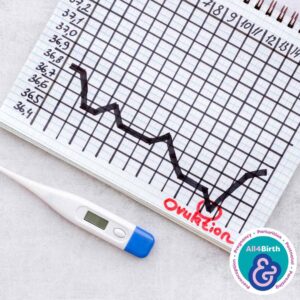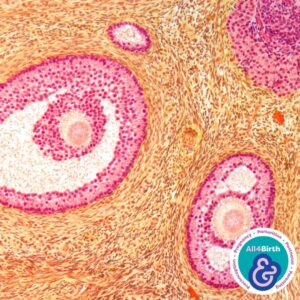Abbie Tomson
Midwife BSc MSc, Yoga Teacher
@enevlorel
Summary
The menstrual cycle is a natural process in women of reproductive age. A complex interplay of hormones regulates it and involves the shedding of the uterine lining through vaginal bleeding. The cycle typically lasts between 21 to 35 days and can vary in length and intensity from woman to woman. The menstrual cycle has four phases: the menstrual phase, the follicular phase, the ovulatory phase, and the luteal phase. Each phase is characterised by different hormonal changes and physical symptoms. Understanding the menstrual cycle can help women track their fertility and identify potential issues or irregularities.
What is ‘the ovulatory phase’? 1
The ovulatory phase is a crucial stage in the menstrual cycle during which ovulation occurs. Ovulation is the release of a mature egg (ovum) from one of the ovaries, and it typically happens around the middle of the menstrual cycle.
Here’s a brief overview of the ovulatory phase:
- Follicular Development: The ovulatory phase follows the follicular phase, during which the pituitary gland releases follicle-stimulating hormone (FSH). This hormone stimulates the development of several ovarian follicles, each containing an immature egg. As these follicles grow, they produce increasing amounts of oestrogen.
- Luteinising Hormone (LH) Surge: As oestrogen levels rise, they eventually trigger a surge in LH. This surge usually occurs around the middle of the menstrual cycle.
- Ovulation: The surge in LH signals the mature follicle to release its egg from the ovary. This is ovulation. The released egg is then swept into the fallopian tube, where it may meet sperm for fertilisation.
- Corpus Luteum Formation: After ovulation, the ruptured follicle transforms into a corpus luteum structure. The corpus luteum produces progesterone, which helps prepare the uterine lining for a potential pregnancy.
If fertilisation does not occur, the corpus luteum degenerates, leading to a drop in progesterone and estrogen levels. This decline triggers the onset of the luteal phase, followed by menstruation if pregnancy has not occurred.
The ovulatory phase is a critical period for women trying to conceive, representing the most fertile time in the menstrual cycle.
What is typically ‘normal’ in the ovulatory phase?
During the ovulatory phase of the menstrual cycle, several physiological changes occur in a woman’s body. These changes are influenced by hormonal fluctuations and are geared towards creating an optimal environment for fertilisation and conception. Here are some normal occurrences during the ovulatory phase:
- Basal Body Temperature (BBT) Rise: After ovulation, there is a slight increase in basal body temperature, typically by 0.5 to 1 degree Fahrenheit. This temperature rise is due to the increased progesterone production by the corpus luteum, the structure formed from the ruptured follicle after ovulation. 2
- Cervical Mucus Changes: The consistency and appearance of cervical mucus change during the ovulatory phase. The mucus becomes clearer, thinner, and more slippery, resembling the consistency of egg whites. This change facilitates sperm movement through the cervix and into the uterus. 2
- LH Surge: A surge in LH triggers ovulation. This surge can be detected using ovulation predictor kits, which measure the levels of LH in urine. The LH surge typically occurs about 24 to 36 hours before ovulation. 1
- Mittelschmerz (Ovulation Pain): Some women may experience mild pelvic pain or a twinge on one side of the lower abdomen during ovulation. This is known as mittelschmerz and is thought to be associated with the release of the egg from the ovary. 5
- Increased Libido: Some women report an increase in sexual desire during the ovulatory phase. This heightened libido is believed to be linked to hormonal changes, particularly the rise in oestrogen levels. 1
- Follicle Rupture: Ovulation involves the rupture of the mature ovarian follicle, releasing the egg into the fallopian tube. This release is a crucial event for fertility. 1
It’s important to note that individual experiences may vary, and not all women will notice all of these changes. Factors such as stress, illness, or certain medical conditions can sometimes affect the regularity or intensity of these ovulatory phase symptoms. Understanding these normal changes can be useful for women trying to conceive or practising natural family planning methods. If there are concerns about irregularities in the menstrual cycle or difficulties conceiving, it’s advisable to consult with a healthcare professional.
Symptoms that may prompt investigation into your menstrual phase
Various symptoms or circumstances may prompt investigation of the ovulatory phase, especially for women actively trying to conceive. Here are some situations or symptoms that might lead to further investigation:
- Irregular Menstrual Cycles: If a woman experiences irregular menstrual cycles, where the cycle length varies significantly or the cycles are consistently shorter or longer than the typical 21 to 35 days, it may be an indication to investigate ovulation. 4
- Amenorrhea or Oligomenorrhea: Absence of menstruation (amenorrhea) or infrequent menstruation (oligomenorrhea) may be a sign of irregular ovulation or anovulation (lack of ovulation).
- Menstrual Cycle Tracking Issues: Women actively tracking their menstrual cycles and observing inconsistencies in basal body temperature (BBT) charts, cervical mucus changes, or ovulation predictor kits may want to investigate further. 2
- Ovulatory Pain Issues: While mild pelvic pain or mittelschmerz during ovulation is normal for some women, severe or persistent pain may warrant investigation. 4
- Fertility Concerns: Women trying to conceive who have not been successful for an extended period may consider investigating ovulation as a potential factor. Infertility investigations often include assessing the regularity and timing of ovulation. 7
- Hormonal Imbalance Symptoms: Hormonal imbalances, such as excessive facial hair growth (hirsutism), acne, or irregular periods, may indicate issues with ovulation and warrant further investigation. 7
- Medical Conditions: Certain medical conditions, such as polycystic ovary syndrome (PCOS) or thyroid disorders, can affect ovulation. Symptoms associated with these conditions may prompt investigation.
- Underlying Health Concerns: Overall health can impact the menstrual cycle. Chronic illnesses, stress, extreme weight changes, or excessive exercise can influence hormonal balance and may be investigated if ovulatory issues are suspected. 7
If a woman experiences any of these symptoms or concerns, it’s advisable to consult with a healthcare professional. The investigation may involve tracking menstrual cycles, hormonal assessments, imaging studies (such as ultrasound), or other specialised tests to determine the underlying cause of any ovulatory issues. Early identification and addressing potential problems can be crucial for women trying to conceive or those with concerns about their reproductive health.
Why is an understanding of the ovulatory phase important when trying to conceive? 1
Understanding the ovulatory phase is crucial when trying to conceive because it represents the peak fertility period in a woman’s menstrual cycle. Here are several reasons why an understanding of the ovulatory phase is important for couples who are trying to get pregnant:
- Optimal Timing for Conception: The ovulatory phase is when the mature egg is released from the ovary and available for fertilisation. Couples who are trying to conceive can increase their chances of success by engaging in sexual intercourse during this fertile window. 1
- Limited Fertility Window: The fertility window is relatively narrow, lasting only a few days around the time of ovulation. Sperm can survive within the female reproductive tract for a short time, while the egg is viable for about 12-24 hours after ovulation. Therefore, having intercourse in the days leading up to ovulation is important for maximising the chances of conception. 1
- Natural Family Planning: Understanding the ovulatory phase is essential for those practising natural family planning. By tracking menstrual cycles, monitoring basal body temperature, and observing changes in cervical mucus, couples can identify the fertile period and either aim to conceive or avoid intercourse for contraception purposes. 2
- Reducing Time to Conception: Knowledge of the ovulatory phase helps couples time their attempts to conceive more effectively. This can potentially reduce the time it takes to achieve pregnancy, particularly for couples who may not be aware of their fertile window.
- Addressing Potential Issues: If a woman is aware of irregularities in her ovulatory cycle, such as anovulation or irregular ovulation, early identification can prompt her to seek medical advice. Identifying and addressing any underlying issues can improve fertility outcomes. 4
- Minimising Stress: Trying to conceive can be emotionally and physically taxing. Understanding the menstrual cycle and ovulatory phase can give couples a sense of control and empowerment, minimizing stress associated with the uncertainty of conception.
- Seeking Professional Help: If a couple has been actively trying to conceive for an extended period without success, knowledge of the ovulatory phase becomes even more critical. It provides valuable information for healthcare professionals to assess potential issues and guide further fertility investigations or interventions. 4
In summary, understanding the ovulatory phase is fundamental to family planning and conception. It allows couples to optimize their chances of conceiving, empowers them to make informed decisions about timing, and can assist healthcare professionals in addressing potential fertility concerns.
.
Links to other resources
 Articles
Articles
Periods and Fertility in the Menstrual Cycle | NHS
Menstrual Cycle and Getting Pregnant | Tommy’s
 Books
Books
It Starts with an Egg | Rebecca Fett
Taking Charge of Your Fertility | Toni Weschler
 Film Audio
Film Audio
 Websites
Websites
References
- Weschler, T. (2016). Taking Charge of Your Fertility: The Definitive Guide to Natural Birth Control, Pregnancy Achievement, and Reproductive Health. Random House
- Werner, M. D., & Kobe, C. J. (2017). Monitoring of Fertility and Early Pregnancy in the St. Petersburg–Tampa Bay Area (MONARCH). PLoS One, 12(10), e0186052. https://doi.org/10.1371/journal.pone.0186052
- Nakayama, T., Suzuki, M., & Ishizuka, N. (1975). The action of progesterone on preoptic thermosensitive neurones. Nature, 258(5530), 80. https://doi.org/10.1038/258080a0
- Mayo Clinic. (2021). Menstrual cycle: What’s normal, what’s not. https://www.mayoclinic.org/healthy-lifestyle/womens-health/in-depth/menstrual-cycle/art-20047186#:~:text=What’s%20typical%3F,last%202%20to%207%20days
- Brott, N. R., & Le, J. K. (2023). Mittelschmerz. In StatPearls. StatPearls Publishing.
- Vigil, P., Lyon, C., Flores, B., Rioseco, H., & Serrano, F. (2017). Ovulation, a sign of health. The Linacre quarterly, 84(4), 343–355. https://doi.org/10.1080/00243639.2017.1394053











